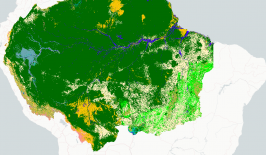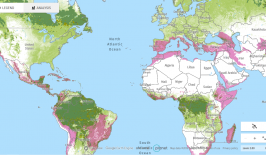It might be cliche, but rainforests and woods really are the ‘lungs of the Earth’. Their ability to sequester and store large amounts of carbon makes them an ideal, cheap, long term and environmentally beneficial solution to some of our climate woes. However, knowing exactly where trees are helping to make an impact, and where they are on decline is not an easy feat – especially on a global scale.
That’s where new organization CTrees comes in. Developed by a team of NASA scientists, CTrees hopes to make data regarding our world’s trees transparent, accurate and available in minute detail. In fact, the team suggests their platform is able to predict the carbon sequestration capability of individual trees and update this in near real time.
CTrees uses a combination of publicly available data, satellite imagery and AI analysis to provide overviews on carbon density for both entire nations, specific jurisdictions and local biomass. In addition, the CTrees platform also integrates information on deforestation, degradation, fire damage as well as regeneration to monitor and verify the condition of forests around the world.
Thanks to high-resolution commercial satellite imagery, users can even zoom into areas and get an accurate estimate on the carbon density value of single trees in the area. All of this information allows users to assess their reforestation efforts, and become alerted to local issue areas.
All of this is important in global and national efforts to combat climate change. The 2015 Paris Climate Agreement pledged many nations to specific carbon reduction goals, as well as other environmentally positive policies. Included within this are mass reforestation projects, as well as carbon offsetting within the so-called carbon market. However, this area is often defined by poor accounting practices, making it difficult to accurately assess where carbon is actually being reduced, or simply being shifted around.
Reforestation especially is a tricky area to monitor. To address this, the COP21 conference mandated the use of REDD+, a framework for the promotion and monitoring of reforestation policies. However, such self-reporting methods are voluntary and not always reliable, especially when combined with huge pledges. For example, in 2020, the World Economic Forum announced the Trillion Trees Campaign which aims to plant one trillion trees across the globe by 2030. Included within the initiative are pledges from the US to plant 51 billion trees, and from China to plant 70 billion trees.
Such pledges sound great, but a major issue is actually tracking how the signatories are doing in their efforts. Many actors themselves simply do not have the tools to accurately monitor and evaluate their own efforts, meaning their reports may be at best inaccurate, or at worst deliberately misreported. Furthermore, simply planting trees en masse is not as straight forward as it seems. The correct species must be planted in the correct location to avoid the spread of disease, monocultures and upsetting the local ecosystem.
Platforms like CTrees not only allow governments to improve their assessments, but also third parties to provide an extra level of oversight and accountability. The CTrees information can be arranged into national boundaries, allowing the individual Nationally Determined Commitments (NDCs) of states to be monitored. Its overviews can also direct reforestation to the areas it is needed most and compare reforestation to deforestation to give an indication of where progress is being made.
With powerful open-source tools like CTrees available to all, civic actors can hopefully better tie governments to their pledges and reduce the amount of greenwashing that often occurs in relation to national climate goals.










